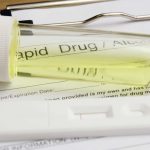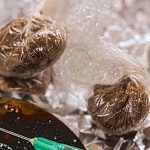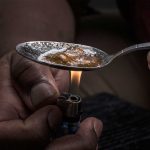Black tar heroin can be identified by its dark color, hard and sticky feel, resemblance to roofing tar, and acidic smell. Black tar heroin’s appearance and feel are different from pure heroin, a solid form that is sold as either white or brown powder.
A 2016 study found higher rates of black tar heroin use in the western United States compared to the eastern U.S. A significant portion of black tar heroin is produced in Mexico, which is then smuggled into the U.S. and other countries.
All forms of heroin are illicit drugs in the United States. When heroin is a subject of substance abuse, it can cause severe side effects such as bacterial infections, withdrawal symptoms, and opiate addiction.
Black Tar Heroin Vs. Heroin Powder
Both black tar heroin and heroin powder come from the opium poppy plant. During production, certain ingredients can be added to change the final heroin product. Black tar heroin can also be ground down to impure heroin powder using common household drug paraphernalia.
Heroin is sold as a light brown or white powder by illicit drug dealers. Powder heroin is a form of pure heroin that can be injected, snorted, or smoked.
Black tar heroin is made with impure processing methods, which can give it its dark color. Additives can also change the look, feel, and effects of black tar heroin. Impurities that often end up in black tar heroin include:
- lactose
- Benadryl
- laxatives
- coffee creamer
Signs Of Black Tar Heroin Use
Ingesting black tar heroin can cause a number of physical and mental health effects. If you suspect a loved one may be abusing heroin, there are some symptoms you can look out for.
Wound Botulism
Injection drug use is a common method of using black tar heroin. The substance may be injected directly into the veins, under the skin, or into the muscles. Injecting heroin can increase the risk of conditions such as HIV, hepatitis, or wound botulism.
Wound botulism can be a dangerous side effect of injecting heroin. It is a specific type of bacterial infection that is toxic to the body. Wound botulism can cause serious side effects if left untreated, such as difficulty seeing, dry mouth, slurred speech, and even paralysis.
If you see these symptoms in yourself or a loved one, get help right away.
Heroin Addiction
Heroin addiction is a serious mental health problem defined by an inability to stop using heroin. Injecting black tar heroin can increase tolerance, which means higher doses may be needed to feel the same effects.
Potential signs of heroin addiction include decreased production at school or work, changes in sociability, and severe heroin cravings.
Heroin use may affect the ingestion site, which is often the nose or the veins. Injecting heroin can lead to collapsed veins and scars at the injection site, while inhaling heroin may permanently damage the nasal passages.
Treating Opioid Addiction
Both short-term and long-term heroin use can lead to infections, drug addiction, overdose, and other long-term health effects.
Treating opioid use disorder may start with a detox program, where heroin is flushed out of the body. After a successful detox, patients may go through behavioral therapy while their withdrawal symptoms are managed with medications like methadone.
To learn about our outpatient programs for heroin addiction, please contact Northeast Addictions Treatment Center today.
Sources
- JAMA Network — Wound Botulism Associated With Black Tar Heroin Among Injecting Drug Users
- National Institute on Drug Abuse — What is heroin and how is it used?
- National Library of Medicine: PubMed — An Exploratory Study of Inhalers and Injectors Who Used Black Tar Heroin
- National Library of Medicine: PubMed — The Textures of Heroin: User Perspectives on “Black Tar” and Powder Heroin in Two US Cities
- U.S. Drug Enforcement Administration (DEA) — Drug Fact Sheet: Heroin
Written by
Northeast Addition Editorial Team
©2024 Northeast Addition Center | All Rights Reserved
This page does not provide medical advice.




